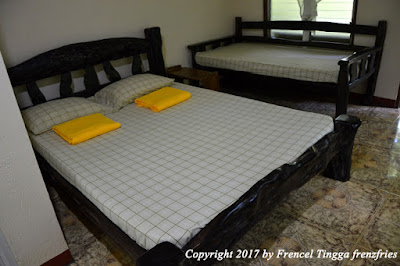Did you know that you need 45 coffee beans to make 1
cup of coffee?
That’s
one of the most interesting facts I learned from Bert Arenal during my stay at
Coffee Farmhouse in Alfonso, Cavite. Kaya pala that instant coffee is called Blend 45 and not Blend 55. Coffee connoisseurs and those who want to learn about
Coffee 101 would surely love this one-of-a-kind bed and breakfast place that
reveres the world’s most popular drink.
It was in 2004 that Bert and his wife Bebet acquired the one-hectare coffee plantation in a derelict state. It was their post retirement investment. The lot was supposed to be converted into a farm subdivision but due to some unforeseen reason, it did not push thru. Since the land is abundant with coffee trees, Bert devoted his free time studying about coffee farming. He initially ventured into coffee trading; but he learned it wasn’t viable in the long run. Some of his friends and colleagues who had the chance to visit and stay at the farm, actually enjoyed his hidden sanctuary and the change of scenery – since the whole place is lush, has a relaxing ambience and the air still fresh. By word of mouth, many got interested in visiting his place because of its unique concept. In 2007, he finally opened his farmhouse to the public.
The farmhouse is about 5 kms. away from Tagaytay-Nasugbu highway so it has that seclusion-feel.
My coffee orientation started the moment I entered the green gate of the farmhouse. Along the winding pathway leading to the mainhouse, are some printed trivia about coffee such as “Coffee trees originated from Ethiopia”; “Scandinavia is the world’s largest coffee consumer per capita”; “In the Philippines, average consumption is 3 cups of coffee daily or 240 million cups a year”; and “The quality of coffee is judged more on aroma than flavour” (mas mabango, mas masarap).
Three varieties of coffee are growing in the farmhouse – Robusta (coffee with high caffeine content; destined to be instant coffee – in short the least desirable among the varities), Excelsa (marked by its distinct jackfruit flavour) and Liberica (known as the big bean or barako by the locals, characterized by its strong pungent aroma). Only Arabica, the most premium type of coffee (and the one mainly used by Starbucks), could not thrive as it is best grown in higher elevation and cooler temperatures. Coffee is usually harvested once a year from January to March. Since it is not yet harvest time, coffee fruits are still green.
There are four types of room accommodation in the farmhouse excitingly named after coffee varieties. All the rooms are naturally ventilated and have no ACs, TV or wi-fi so guests could temporarily disconnect from the digital world.
The Robusta House is a duplex with each room good for couple.
The Arabica House is good for big families and barkadas since it has two adjoining rooms.
The Excelsa House is the dormitory which is good for bigger groups on teambuilding, retreat or seminar.
And the Liberica Main House, which has two rooms good for small family group.
Its sala and dining hall also serve as common space for guests. There are books, DVDs, boardgames, and sungka for recreation and entertainment.
The farmhouse offers full-board meals (four main meals and three snacks) for those staying overnight. Bebet is in-charge of the kitchen and prepares delicious lutong bahay meals. I enjoyed her hefty serving of soup, garden salad, daing na bangus, danngit, tapsilog, lumpiang hubad, tokwa’t baboy, beef stew, chicken inasal, sweets and fresh fruits.
And since they grow, dry, roast and grind their own coffee, organic brewed kapeng barako is free-flowing. With creamer, it tastes really good.
The best activity inside the farmhouse (aside from eating) is the educational tour and a short lecture on coffee conducted for free by Bert. He is a coffee expert and I learned several things from him - “Kaldi, an Abyssinian goat herder might have discovered the coffee (according to legend)”; “Brazil and Vietnam are today’s world’s largest coffee producers”; “coffee berries change from green to red in 6-8 months (that’s how long before harvest time)”; “it’s really not the saliva and enzyme of the civet that make coffee luwak the most tasty; rather civets only eat the best among the coffee berries”; and “true coffee lovers mainly drink espresso”. He also has this collection of coffee makers from traditional to more modern, to show the evolution of coffee-making.
There are several recreational facilities and activities to do within the farmhouse like biking, strolling, swimming, basketball, volleyball, badminton, table tennis, billiards, darts, camping, and relaxing on hammock under coffee trees. I got reenergized communing with mother nature.
The farmhouse is a charming 3-in-1 experience combining coffee, playground and sanctuary.
I got hooked listening to Bert’s personal story from acquiring to managing the
farmhouse, from his little frustrations to deep, meaningful joy his farmhouse
has brought to him, and how he hopes that one day his son Inigo would
wholeheartedly take over in running their family business. At his age with a
professional background on oil business, Bert never imagined that he will
venture into agri-business or farm tourism. But then again, as they say, better
latte than never.
From Manila, take Nasugbu-bound bus from Buendia or
South Terminal in Pasay. Get off at Splendido in Brgy. Upli, Alfonso. From the
highway, take a tricycle going to the farmhouse.
Coffee Farmhouse
23 Palumlum-Matagbak Rd.
Brgy. Palumlum, Alfonso, Cavite
Tel. No.: 0928-5000599









































1 comment:
Great writeup! I checked out your blog site pretty often,
and you are constantly coming up with some great staff. I
shared this post on my Twitter, and my followers liked it!
Keep up the good work.
Post a Comment